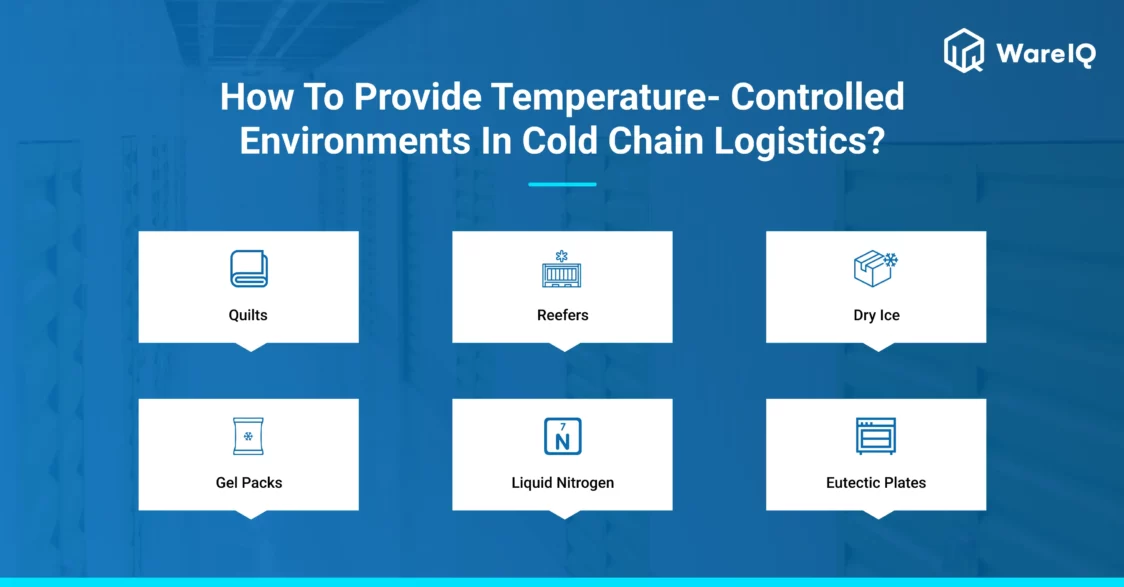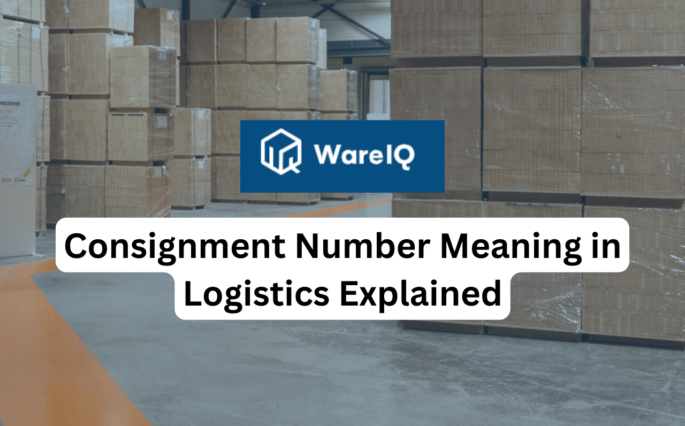Cold Chain Logistics Guide: How To Effectively Perform Temperature-Controlled Warehousing and Shipping?

We’re all aware of how globalization in trade and commercial sectors has bridged the gaps between nations and connected the world in a more economical, technological, and innovative way, but it does not technically dissolve the physical distance between these nations. Hence, the evolution of global trading between countries had to be resolved through the safe transit of goods using cold chain logistics.
In a simpler analysis, you can create a small temperature-controlled packaging by simply filling your plastic bag with ice to carry your ice cream home without melting it, but transporting tonnes of perishable items as cargo to thousands of miles away requires time, effective coordination and most importantly temperature controlled logistics to prevent it from getting damaged.
To ensure that cargo does not get damaged because of undue temperatures, shock, or any other external factors, manufacturing companies like pharmaceutical, medical, and food rely on cold chain logistics as an important part of their eCommerce operation. In this article, we will explore key information on cold chain logistics so that it can be implemented in your business logistics requirements.
- What is Cold Chain Logistics?
- Elements Of A Cold Chain Logistics
- How To Provide Temperature-Controlled Environments In Cold Chain Logistics?
- Differences Between Cold Chain and Normal Supply Chain
- Benefits Of Cold Chain Logistics
- Cold Chain Logistics Use Cases
- Cold Chain Standards And Regulations
- Common Cold Chain Management Issues
- WareIQ: Fulfilling Cold Chain Logistics Across India
- Cold Chain Logistics: FAQs
What is Cold Chain Logistics?
Cold chain logistics is the science, technology, and process that is required in the transportation of temperature-sensitive products during the supply chain operation employing technology like temperature-controlled packaging methods and effective coordination and planning of the transit operation.
To execute a cold-chain logistics operation, deep knowledge, and understanding are required of the perishability of the items that you will be shipping. Further, cold chain logistics is completely dependent on physical technologies that ensure that due temperatures are controlled throughout the operation. Some of these technologies and methods include refrigerated trucks and rail cars, temperature-controlled containers in cargo ships, and air cargo.
WareIQ, an eCommerce fulfillment company, empowers online brands with a superior-tech platform to compete with Amazon like service levels by bringing their average delivery timelines from 5-10 days to 1-2 days.
Elements Of A Cold Chain Logistics

Cold chain logistics is a comprehensive process of preparing, storing, transporting, and monitoring temperature-sensitive products that need to be shipped. Hence a lot of components are involved that you must be aware of before executing such a logistics operation. These elements involve :
- Cooling Systems – These systems are utilized to bring the goods to the required temperature and manage it during every supply chain process, including processing, storing, and transporting.
- Cold Storage – These are facilities where goods and products are stored with temperature-controlled technology, waiting to be transported.
- Cold Transport – Temperature and humid controlled containers where the cargo is shipped.
- Cold Processing And Distribution – Cold processing facilities help in the processing of goods with the help of sanitation techniques, and distribution deals with the loading of crates, pallets, and boxes that are also kept in temperature-controlled environments while being distributed.
How To Provide Temperature-Controlled Environments In Cold Chain Logistics?

It is important to note that different types of products require different temperatures and control methods to maintain their integrity and avoid damage. Hence, to implement a cold chain operation, you must have the right knowledge of transporting temperature-controlled cargo and how they should be adapted based on shipping circumstances. The vitality and shelf-life of these products are heavily dependent on how you can successfully maintain the temperature range throughout the supply chain process.
Any temperature-sensitive shipment across an extended period of time will largely depend on the type of container being used, its packaging, and most importantly, the refrigeration method, which accounts for 20% of the energy consumption.
When we speak about packaging, several factors, like the size of shipment, outside temperature, period of transit, etc., must be taken into consideration before deciding what type of technology will be used during the packaging process. Following are some of the cold chain packaging technologies that can help you enable a temperature-controlled environment during transportation.
Suggested Read: What is Custom Packaging?
- Quilts – These are large pieces of insulated materials that are wrapped around or placed over the freight that act as a buffer in temperature variations and keep it relatively constant throughout the transit. Hence, if you want to keep frozen goods at the same temperature, this can be a useful technology, but it does not work as effectively as a refrigerated container. Quilts also help in maintaining the temperature of the freight as opposed to the varying outside conditions.
- Reefers – These are temperature-controlled transportation units like a minivan, small truck, semi-trailer, or an ISO standard container that allows the circulation of temperature-controlled air, which is maintained inside with the help of an independent refrigerator. It can maintain both cool and warm temperatures inside the vehicle.
- Dry Ice – Dry ice is solid carbon-di-oxide at a temperature of about -80°C used to keep frozen shipments like food, pharmaceutical drugs, and exploitative goods in refrigerated unit devices for an extended period, mostly during air cargo transportation.
- Gel Packs – These are phase-changing substances that can go from solid to liquid or vice versa to maintain the internal temperature of the cargo and capture the escaping energy. Gel packs are mostly used to keep large pharmaceutical and medical shipments under their desired range between 2 and 8°C.
- Liquid Nitrogen – This is a chemical substance that remains in the gaseous state at about -196°C, mostly used to keep the cargo frozen over a long period. This is a very hazardous cold storage substance and is mainly used during the transportation of biological cargo like tissues or organs.
- Eutectic Plates– These are cold plates, much like gel packs but can be reused many times. These have a lot of applications but mostly for shorter transits, such as temperature-controlled deliveries in suitable areas, night deliveries, etc.
Suggested Read: Looking for top Cold Storage Companies for Sellers in India?
Differences Between Cold Chain and Normal Supply Chain
| Element | Cold Chain | Normal Supply Chain |
|---|---|---|
| Temperature Control | Temperature-sensitive products are stored and shipped under strict temperature conditions (e.g., refrigerated or frozen) to maintain their quality and integrity. | Temperature control is not a primary concern in the normal supply chain, and products are typically stored and shipped at ambient temperatures. |
| Product Types | Perishable goods, such as food and pharmaceuticals, are highly sensitive to temperature fluctuations and require special handling. | Non-perishable goods that do not require temperature-controlled storage or transport, such as clothing or electronics. |
| Logistics Infrastructure | Cold storage warehouses, refrigerated trucks, and specialized packaging materials are necessary to maintain the appropriate temperature range for the products throughout the supply chain. | Basic warehousing and transportation infrastructure is sufficient for non-perishable products. |
| Shelf-Life | Shorter shelf life due to the sensitivity of the products to temperature fluctuations. | Longer shelf life as non-perishable products do not degrade easily. |
| Cost | Cold chain logistics require specialized infrastructure, equipment, and handling procedures, which can be costly. | Normal supply chain logistics are generally less expensive as they do not require specialized equipment or handling procedures. |
| Regulatory Compliance | Cold chain logistics must comply with strict regulations and guidelines for the storage and transport of temperature-sensitive products. | Regulatory compliance for normal supply chain logistics is generally less stringent. |
| Supply Chain Visibility | Cold chain logistics require real-time monitoring and tracking of temperature conditions to ensure product quality and safety. | Supply chain visibility is essential in the normal supply chain, but real-time monitoring is optional. |
Benefits Of Cold Chain Logistics
Cold chain logistics play an important role in global food safety management by providing vital and good quality food, drugs, and other products to the world’s remotest region. For consumers, it means fresh and standard goods, and for companies in the modern business, it poses the following benefits –
- Reduced product spoilage, thus leading to improved profits.
- Lower the risk of damaged goods reaching the consumers; hence it reduces the possibilities of legal and public relations liabilities.
- Extended shelf life of products, better quality ensuring continuity of goods, repeat orders, and strong customer support.
- An extended transportation area means that companies can now reach new markets and improve export and contributions.
- Since food and medical regulations are strict all over the world, cold chain logistics allows better compliance with these regulations.
Cold Chain Logistics Use Cases
The necessity of new drugs and the constant demand for exotic goods all around the world have made multiple industries, like agriculture, manufacturing, healthcare, etc. to be dependent on cold chain logistics. Let us explore the uses of the same based on specific industries.
Food Industry
Cold chain logistics give you warehousing and transportation facilities that are completely temperature-controlled and maintain humidity levels. Following are some of the general temperature settings for different types of goods –
- Deep Frozen Meat & Seafood : -30° C and -18° C (-22° F and -0.4° F)
- Frozen Meat and Seafood : -18° C and 0° C (-0.4° F and 32° F)
- Perishable Cold Fruits, Vegetables and Dairy Goods : 7° C and 14° C (44.6° F and 57.2° F)
- Fresh Produce : 14° C and 24° C (57.2° F and 75.2° F)
Pharmaceuticals And Healthcare Industry
There has been a steady growth in the demand for cold chain logistics by the pharma industries and it is predicted to be worth $ 21.3 billion by the end of 2024. To maintain the vitality of biological cargo, vaccines, and medicines and to adhere to regulations set by governing bodies, certain temperatures need to be maintained while shipping pharma cargo. These general readings are –
- Medicines : 2° C and 8° C (36° F and 46° F)
- Biological Cargo : 2° to 8°C and sometimes down to -80°C
- Vaccines ( eg COVID – 19) : -70°C
Cold Chain Standards And Regulations
Goods that are shipped using Cold chain logistics are very sensitive and can cause direct implications for public safety. Hence a lot of government institutions and bodies set regulations around the operation to ensure the safe storage and shipping of these goods. Following are some of the standard regulators –
- The US Food and Drugs Administration (FDA) is responsible for developing regulations and standards for the entire supply chain process, including processing, packaging, storage, delivery, and documentation.
- In Europe, the Goods Distribution Practises sets the main standards of packaging and distribution.
- Guidelines for the international packaging and shipping of vaccines are regulated by the World Health Organization (WHO)
- Perishable cargo regulations are standardized by the International Air Transport Organization (IATA)
Further, there are other standalone government institutions and those based on individual countries, like the US Customs, the Transportation Security Administration (TSA), the Department of Transportation (DOT), the Global Cold Chain Alliance (GCCA), etc., that ensure the safety compliance of logistics operations.
Common Cold Chain Management Issues
Cold chain logistics can have management issues and problems during the supply chain operation. Let us recognize them before they can arise –
- Quality Issues with the Product – Thee can be product quality issues with the cargo from the beginning; hence cleaning, sorting, and proper sanitization processes must be done before packaging and loading.
- Improper Packaging – This can lead to contamination and damage of the product during transportation.
- Improper Documentation – Cold chain logistics operations require proper documentation and record keeping, especially because these stored records analyze important information like storage temperatures, handling instructions, etc., which is crucial to prevent unavoidable conditions from spoiling the load.
- Transportation Delays – Cold chain logistics are very time sensitive, and any delay in shipment or transportation can destroy the cargo.
- External Conditions – Variations in temperature due to external conditions like hot climate, improper handling, improper pre-cooling, leaving the doors open, loading, faulty cooling containers, etc., can create huge problems during cold chain logistics.
WareIQ: Fulfilling Cold Chain Logistics Across India
Today 3PL and other freight forwarding companies have been taking the burden of cold chain logistics enforcement off the shoulders of manufacturers across various verticals. these companies provide guided expectations and exceptional services fuelled by expertise when it comes to transporting goods that are temperature sensitive.
One of the most important aspects that go unnoticed in executing cold chain logistics is integration planning and control of various elements of the supply chain. This can only be done with the proper use of data that can be curated manually from various sources. With the rise in the demand for cold chain logistics, 3PL and other logistics companies are rigorously investing in smart technology and data science to harmonize the entire operation. It is to be noted that data is streamlining industries and allowing more accurate decisions to be made in logistics.
Such accuracy is very important when dealing with time-sensitive perishable items, which in the likelihood of getting damaged or destroyed, can cause huge losses to the reputation and functionality of any business. Modern practices in cold chain logistics and the constant evolution and technological contribution in the industry have led to a steep decline in the possibility of an error.
Who knows, soon we might be able to send millions of goods across the world in just a matter of time and with intact quality and greater ease, creating endless possibilities and opportunities for expansion and development in the remotest of regions. The sector has a long way to go, but the beginning is here.










